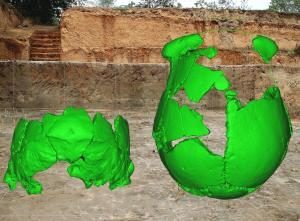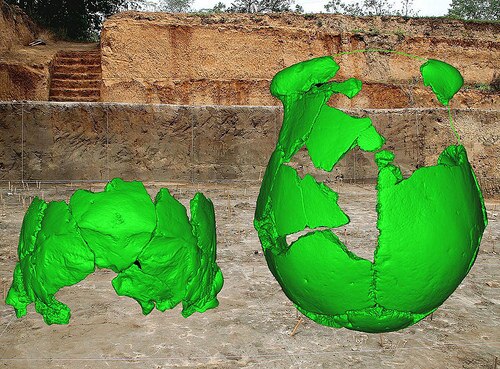
WASHINGTON UNIVERSITY IN ST. LOUIS—Two partial archaic human skulls, from the Lingjing site, Xuchang, central China, provide a new window into the biology and population patterns of the immediate predecessors of modern humans in eastern Eurasia.
Securely dated to about 100,000 years ago, the Xuchang fossils present a mosaic of features.
- With late archaic (and early modern) humans across the Old World, they share a large brain size and lightly built cranial vaults with modest brow ridges.
- With earlier (Middle Pleistocene) eastern Eurasian humans, they share a low and broad braincase, one that rounds onto the inferior skull.
- With western Eurasian Neandertals, they share two distinct features—the configuration of their semicircular canals and the detailed arrangement of the rear of the skull.
_________________________________________
Virtual reconstructions of the Xuchang 1 and 2 human crania are superimposed on the archeological site where they were discovered. Credit: Xiujie Wu
_______________________________________________________
“The biological nature of the immediate predecessors of modern humans in eastern Eurasia has been poorly known from the human fossil record,” said Erik Trinkaus, a corresponding author for the study and professor of anthropology at Washington University in St. Louis. “The discovery of these skulls of late archaic humans, from Xuchang, substantially increases our knowledge of these people.”
More importantly, he noted: “The features of these fossils reinforce a pattern of regional population continuity in eastern Eurasia, combined with shared long-term trends in human biology and populational connections across Eurasia. They reinforce the unity and dynamic nature of human evolution leading up to modern human emergence.”
Article Source: Washington University in St. Louis news release
________________________________________________________
The study is co-authored by researchers from institutions in Beijing, Zhengzhou and Shanghai, China, including Zhan-Yang Li, Xiu-Jie Wu, Wu Liu, Xing Gao, Xiao-Mei Nian and Li-Ping Zhou. The work was supported by the National Natural Science Foundation of China and the Chinese Academy of Science.
Li, Z.Y., Wu, X.J., Zhou, L.P., Liu, W., Gao, X., Nian, M.N., Trinkaus, E. (2017) Late Pleistocene archaic human crania from Xuchang, China. Science (in press).
________________________________________________________
Subscribe to Popular Archaeology Premium. Available on all laptops and mobile devices, and still the industry’s best value at only $9.00 annually.
___________________________________________
Travel and learn with Far Horizons.
____________________________________________
This richly illustrated issue includes the following stories: Recent findings shedding new light on the whereabouts of the remains of Philip of Macedon, father of Alexander the Great; how an archaeologist-sculptor is bringing bones of the dead back to life; archaeologists uncovering town life at the dawn of civilization; an exclusive interview with internationally acclaimed archaeologist James M. Adovasio about what makes the Meadowcroft Rockshelter prominent in the ongoing search for the first Americans; what archaeologists are finding at the site of the ancient city of Gath, the home town of the biblical Philistine giant, Goliath; and how scientists are redrawing the picture of human evolution in Europe. Find it on Amazon.com.







